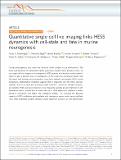Files in this item
Quantitative single-cell live imaging links HES5 dynamics with cell-state and fate in murine neurogenesis
Item metadata
| dc.contributor.author | Manning, Cerys S. | |
| dc.contributor.author | Biga, Veronica | |
| dc.contributor.author | Boyd, James | |
| dc.contributor.author | Kursawe, Jochen | |
| dc.contributor.author | Ymisson, Bodvar | |
| dc.contributor.author | Spiller, David G. | |
| dc.contributor.author | Sanderson, Christopher M. | |
| dc.contributor.author | Galla, Tobias | |
| dc.contributor.author | Rattray, Magnus | |
| dc.contributor.author | Papalopulu, Nancy | |
| dc.date.accessioned | 2019-08-08T14:30:07Z | |
| dc.date.available | 2019-08-08T14:30:07Z | |
| dc.date.issued | 2019-06-27 | |
| dc.identifier | 260459442 | |
| dc.identifier | b1d82ea0-4f23-4045-a14d-c099c241f5c3 | |
| dc.identifier | 31249377 | |
| dc.identifier | 85068080331 | |
| dc.identifier.citation | Manning , C S , Biga , V , Boyd , J , Kursawe , J , Ymisson , B , Spiller , D G , Sanderson , C M , Galla , T , Rattray , M & Papalopulu , N 2019 , ' Quantitative single-cell live imaging links HES5 dynamics with cell-state and fate in murine neurogenesis ' , Nature Communications , vol. 10 , 2835 . https://doi.org/10.1038/s41467-019-10734-8 | en |
| dc.identifier.issn | 2041-1723 | |
| dc.identifier.other | PubMedCentral: PMC6597611 | |
| dc.identifier.other | ORCID: /0000-0002-0314-9623/work/60427778 | |
| dc.identifier.uri | https://hdl.handle.net/10023/18276 | |
| dc.description | Funding: V.B. and J.K. were supported by a Wellcome Trust Senior Research Fellowship to N.P. (090868/Z/09/Z) | en |
| dc.description.abstract | During embryogenesis cells make fate decisions within complex tissue environments. The levels and dynamics of transcription factor expression regulate these decisions. Here, we use single cell live imaging of an endogenous HES5 reporter and absolute protein quantification to gain a dynamic view of neurogenesis in the embryonic mammalian spinal cord. We report that dividing neural progenitors show both aperiodic and periodic HES5 protein fluctuations. Mathematical modelling suggests that in progenitor cells the HES5 oscillator operates close to its bifurcation boundary where stochastic conversions between dynamics are possible. HES5 expression becomes more frequently periodic as cells transition to differentiation which, coupled with an overall decline in HES5 expression, creates a transient period of oscillations with higher fold expression change. This increases the decoding capacity of HES5 oscillations and correlates with interneuron versus motor neuron cell fate. Thus, HES5 undergoes complex changes in gene expression dynamics as cells differentiate. | |
| dc.format.extent | 19 | |
| dc.format.extent | 3932456 | |
| dc.language.iso | eng | |
| dc.relation.ispartof | Nature Communications | en |
| dc.subject | QA Mathematics | en |
| dc.subject | QH301 Biology | en |
| dc.subject | DAS | en |
| dc.subject | BDC | en |
| dc.subject | R2C | en |
| dc.subject.lcc | QA | en |
| dc.subject.lcc | QH301 | en |
| dc.title | Quantitative single-cell live imaging links HES5 dynamics with cell-state and fate in murine neurogenesis | en |
| dc.type | Journal article | en |
| dc.contributor.institution | University of St Andrews. Applied Mathematics | en |
| dc.identifier.doi | 10.1038/s41467-019-10734-8 | |
| dc.description.status | Peer reviewed | en |
This item appears in the following Collection(s)
Items in the St Andrews Research Repository are protected by copyright, with all rights reserved, unless otherwise indicated.

